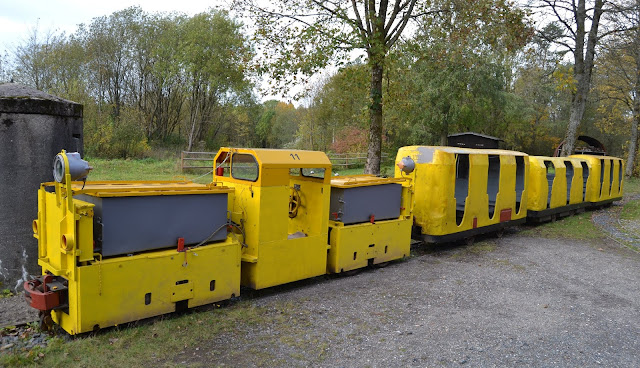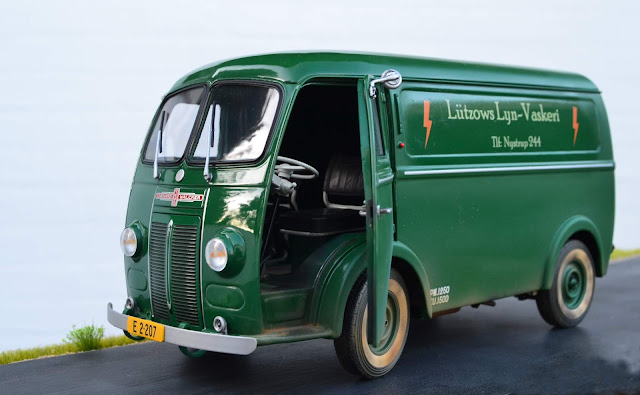 |
| A brief pause while unloading overburden along a road. The relatively warm weather is reflected in the light clothing worn by the men. |
In 2019 I managed to add no less than 8 skips to my collection and triple the skip fleet of Nystrup Gravel. I can now run trains of skips with a decent length and combined the skips will make up a train a full meter in length. During the summer I added two Hudson Rugga skips complete with weathering and prototypical coupling chains to the two already in service. The Hudson skips are made from kits brought out many years ago by Binnie Engineering.
 |
| 4 Hudson skips parked on the Nystrup Gravel main line. All the skips have had minor alternations and extra detail built into them. Decals supplied by one of the small businesses (in this case Skilteskoven) that cares for modellers with special needs. |
As skips are what makes the little railway at Nystrup Gravel earn its living, I knew I had to have more than 4 Hudsons. Quite satisfied with both the look and running of the Binnie Engineering Hudson skips, the type was however, never in widespread use in Denmark. Consequently I couldn't bring myself to buy more of them. Fortunately I was able to aquire 6 skips of a standard German type in the autumn bringing my skip fleet to a total of 10. The 6 new skips will have to be painted, numbered and weathered. A task for 2020.
2019 also saw me finish the first Nystrup Gravel locomotive in 16 mm scale. A somewhat rebuilt I. P. Engineering Lister R was taken into service during the late summer and has turned out a very reliable machine. Just what scale the kit is actually made to is an open question though, as the proportions doesn't fit any of the drawings I have had access to. I tried to improve a few things here and there and cut off no less than 7 mm in width to almost match my scale drawings. No matter what it's a great little locomotive.
 |
| Lister close up from above. The oil can seems to have leaked a bit. |
I have been testing if my library and workshop room could house a small 16 mm scale indoor module. After some reorganizing it turned out that it is possible to cram in a few meters of track and structures on some shelves. It will not be a large layout, but I think I might just squeeze in two points, a small engine shed and perhaps even the legendary flimsy lorry loading ramp over which surprisingly huge amounts of gravel slided down into waiting lorries. At the moment I'm playing around with Peco points and track panels. While it's convenient to be able to aquire track from a quality manufacturer the look of the track isn't particularly to my taste. In 2020 I will have to decide if I will use the Peco track, rebuild it or make my own track from scratch.
In addition to modelling 600 mm gauge industrial railway equipment I enjoy building and modifying road vehicles that fit my modelling theme and period. In 2019 I finished several road vehicles. I managed no less than 4 cars and one steam tractor. In contrast to my old scale 1/35, road vehicles in 16 mm scale are almost exclusively available as diecast models. I have only seen a few 3D-printed vehicles available for 16 mm scale. Consequently I have been modifying, detailing and weathering die cast cars rather than building full kits as before.
 |
| A Tempo Hanseat lorry showed up near Nystrup during 2019. Banke's Bakelite was a small company employing several lorries for transporting raw materials and finished products. |
As usual I visited several narrow gauge railways and museums with industrial heritage content. Visits like those are an important inspiration. In 2019 I joined friends from my heritage railway for a trip to the Internationaler Feldbahnertreffen in Ilmenau, Germany.
 |
| An O&K Montania loco passing the remains of an ore loading facility near the 'Voller Rose' flour spar mine at Ilmenau. |
2019 wasn't the most active year in the Nystrup Gravel blog's existence with two full months without any postings at all mainly due to work obligations. I must have been making up for the missing modelling in other months and followed up with posts as the year's 'production' of blog posts managed to reach a respectable 40. The statistics says the visits are again averaging 2.500-3.000 page views pr month after having taken a dip in the beginning of the year. As me, the readers might have taken some time for adjusting to the new scale.
 |
| A new scale takes some time to get adjusted to. Here's a photo to show the size of two 16 mm scale models in comparison with a well known and standardized object to the right. |













































